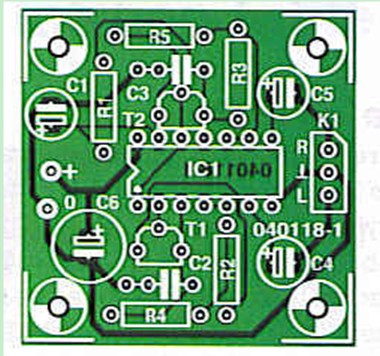

Project Solutions
EAR BOGGLE-Experience an auditory illusion
Published:2011/8/11 20:10:00 Author:Phyllis From:SeekIC
By Rev. Thomas Scarborough
This month we invite all fans of the ’kitchen table’ series to build a classic auditory illusion that has had psychologists and neuroscientists puzzled for decades. Although we’re presenting a mini project built from a handful of cheap parts, it will not fail to produce stunning effects and results.
This article is of the ’zero-hardware / huge background’ variety and as such fits perfectly in our ’kitchen table’ series of mini projects aimed not only at developing electronics skills but also at triggering experimentation. This month, a dead simple two-tone two-phase oscillator produces a mind-boggling effect (quite literally) — guaranteed to cause a good deal of wonder &excitement in the physics and electronics classroom.
In a nutshell
A two-tone ’siren’ or octave switcher plays into stereo headphones. To best create the illusion you or your guinea pig(s) are about to experience, the two tones are separated by one octave (a factor of two in frequency) and alternate at about 4 Hz (250 ms). The siren is played out of phase into each headphone.
According to biology textbooks, each ear would hear a two-tone siren. However what you will actually perceive is best described as a two-tone ping-pong effect which seems to jump from ear to ear. So what has our mind done with the missing tones? Are they being suppressed or what? To add to the confusion, just reverse headphones and — depending on the person’s handedness — the tones are likely to jump back to where they were before. However, let’s not get carried away and first look at the electronics.
The circuit
Figure 1 shows a circuit diagram that’s low in confusion and rich in simplicity. Two oscillators, IC1.B and IC1.E are buffered by IC1.C and IC1.D respectively to play into stereo headphones. The frequency of the oscillators is being modified by switching R2 and R5 in or out of parallel with R4 and R3, by means of Tl and T2. These two FETs are in turn being switched on alternatively (’out of phase’) by means of slow square wave oscillator IC1.F and inverter IC1.A. Since the oscillation frequency of IC1.B (IC1.E) doubles as R2 (R5) is shunted into circuit by Tl (T2), a regular jump of one octave is achieved. 
Although almost any power MOSFET should be suitable for Tl and T2, we’ve opted for a small-signal FET type BS170 which also achieves clean switching and a sufficiently low ’on’ resistance in the drain-source junction. In this circuit, you should aim at using matched components for the tone frequency determining devices, i.e., R2, R4, C2, R5, R3 and C3, to make sure the tones played into each channel match each other—the better the match, the better the illusionary effect.
The circuit is powered from a stable 5-VDC source like a lab supply or an existing supply using a 7805 regulator IC. Current consumption will be no more than a few milliamps.
Construction
The circuit may be built on Veroboard or, for a touch of sophistication, on the printed circuit board shown in Figure 2. The copper track layout of the board may be found on our website, look for file no. 040118-1 in the Free Downloads section, under month of publication. Ready-made boards may be ordered from The PCBShop (Euro-Circuits). 
Building up the board should not pose insurmountable problems as long as you stick closely to the parts list and the component overlay. Polarized components like the four electrolytics, the two FETs and the 40106 IC must, of course, be fitted the right way around, not forgetting the 5-volt power supply wires!
Warning. This circuit is not approved for medical use or research. When using headphones, every precaution should be taken to prevent ear damage by excessive sound levels. The experiments described in this article should not be carried out on persons suffering from seizures or epilepsy.
Reprinted Url Of This Article: http://www.seekic.com/blog/project_solutions/2011/08/11/EAR_BOGGLE_Experience_an_auditory_illusion.html
Print this Page | Comments | Reading(1502)
Article Categories
New published articles
· Imagination works with TSMC to develop FinFET process
Author:Ecco Reading(33516)
· XMOS pushes event-driven MCUs with lower price
Author:Ecco Reading(3534)
· Intel brings upgraded 32-nm SoC for smartphones
Author:Ecco Reading(3250)
· Micron pushes TLC 128-Gbit NAND flash
Author:Ecco Reading(3816)
· Intel will stop supplying desktop motherboards
Author:Ecco Reading(5341)
· Processor market was expected to regain strength in 2013
Author:Ecco Reading(3318)
· It was reported that TSMC sales fall steeply
Author:Ecco Reading(3474)
· Cisco, NXP work with auto wireless startup
Author:Ecco Reading(3620)
· Micron was impacted by manufacturing glitch
Author:Ecco Reading(4017)
· China can make 22-nm transistor by themselves
Author:Ecco Reading(3819)
· Chip market rebound is coming, according to survey
Author:Ecco Reading(3760)
· Sony, Toshiba will spend more on chips, iSuppli reports
Author:Ecco Reading(3790)
· Qualcomm becomes the 13th company to join NFC Forum board
Author:Ecco Reading(6103)
· TSMC increases building work for FinFET fab
Author:Ecco Reading(3778)
· TI plans to cut 1,700 jobs in OMAP shift
Author:Ecco Reading(4587)